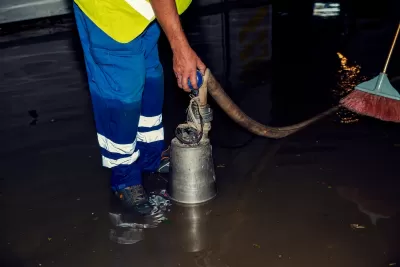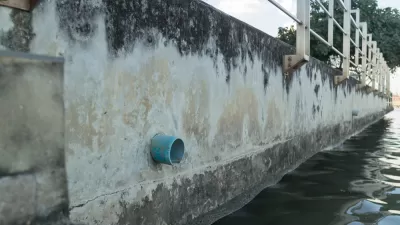Two programs aimed at helping residents safely clean up overflows caused by aging pipes are in limbo due to a dispute between the city and the EPA.

Baltimore residents are left unable to access a program meant to assist them with the cleanup from sewage backups, reports Aman Azhar for Inside Climate News.
As Azhar explains, “Baltimore City runs two cleanup programs aimed at providing relief to homeowners, tenants and property managers dealing with sewage backup entering their homes due to wet weather conditions and clogged public pipes.” Now, a dispute between the city and the EPA has stalled the programs.
According to Baltimore DPW Director Richard Luna, the department rejected all 23 applications for funds under the Expedited Reimbursement Program in 2023 and approved 3 out of 33 applications in 2024. “Under the SOS program, Luna said, around $77,000 was given to 11 households in 2023 and four households properties received nearly $44,000 in 2024.”
“A 2019 study documented a number of diseases linked to fecal matter in Baltimore wastewater, which often inundated residents’ homes and basements as a result of a sewage backup. Raw sewage can be especially harmful when residents are forced to undertake the cleanup themselves because it contains pathogens such as bacteria, viruses, and parasites, the study said.” Meanwhile, climate change is causing more frequent and severe storms that cause sewer overflows, the report warns.

Study: Maui’s Plan to Convert Vacation Rentals to Long-Term Housing Could Cause Nearly $1 Billion Economic Loss
The plan would reduce visitor accommodation by 25,% resulting in 1,900 jobs lost.

North Texas Transit Leaders Tout Benefits of TOD for Growing Region
At a summit focused on transit-oriented development, policymakers discussed how North Texas’ expanded light rail system can serve as a tool for economic growth.

Why Should We Subsidize Public Transportation?
Many public transit agencies face financial stress due to rising costs, declining fare revenue, and declining subsidies. Transit advocates must provide a strong business case for increasing public transit funding.

How to Make US Trains Faster
Changes to boarding platforms and a switch to electric trains could improve U.S. passenger rail service without the added cost of high-speed rail.

Columbia’s Revitalized ‘Loop’ Is a Hub for Local Entrepreneurs
A focus on small businesses is helping a commercial corridor in Columbia, Missouri thrive.

Invasive Insect Threatens Minnesota’s Ash Forests
The Emerald Ash Borer is a rapidly spreading invasive pest threatening Minnesota’s ash trees, and homeowners are encouraged to plant diverse replacement species, avoid moving ash firewood, and monitor for signs of infestation.
Urban Design for Planners 1: Software Tools
This six-course series explores essential urban design concepts using open source software and equips planners with the tools they need to participate fully in the urban design process.
Planning for Universal Design
Learn the tools for implementing Universal Design in planning regulations.
City of Santa Clarita
Ascent Environmental
Institute for Housing and Urban Development Studies (IHS)
City of Grandview
Harvard GSD Executive Education
Toledo-Lucas County Plan Commissions
Salt Lake City
NYU Wagner Graduate School of Public Service





























